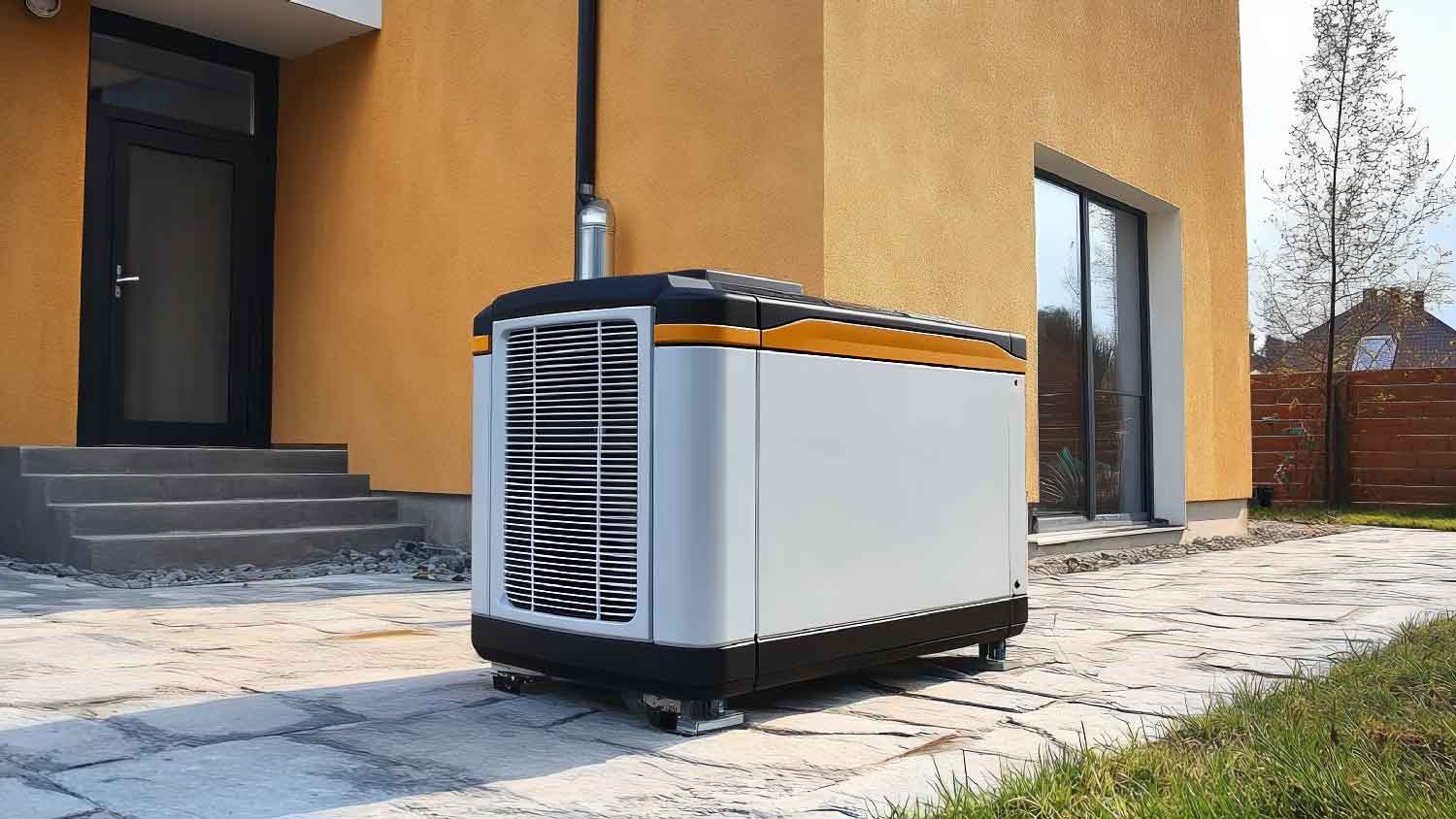
The cost to install a generator transfer switch depends on several factors. Our guide will help you understand all of the costs.
The average U.S. homeowner spends about $5,170 to install a new whole-house generator. Depending on the size, assembly, brand, and fuel type, most spend between $1,539 and $8,830.


A 7.5 to 10kW generator can power all essential appliances for around $2,000 to $3,500.
Whole home generators (22kW to 48kW) start around $5,000, depending on your electrical needs.
Gas generators are nearly 7x more affordable to run than natural gas, propane, or diesel.
Automatic start generators are far more expensive than manual ones, but pay dividends in emergencies.
Don’t forget to budget about $2,200 for a concrete pad and electrical work.
| Expense | Average Cost | Distances Requiring More Than 20 kW |
|---|---|---|
| Whole-house generator | $500–$5,000 | $5,000–$18,000 |
| Labor and installation | $1,500–$5,000 | $5,000–$12,000 |
Whether you live off the grid, frequently lose power, or depend on electricity for your medical needs, a generator is an essential household tool. A whole-house generator costs between $1,539 and $8,830 or $5,170 on average. Knowing how much you’ll spend on this useful equipment can prove challenging, so follow this guide to learn the whole-house generator cost.
The cost of your home generator will depend on the type you choose and its particular installation requirements.
There are several types of generators worth considering when determining whether a whole-house generator is right for you.
| Generator Type | Generator Capacity | Average Cost |
|---|---|---|
| Portable generators | 1kW–7.5kW | $500–$2,000 |
| Partial generators | 9kW–20kW | $2,000–$6,300 |
| Whole-house generators | 22kW–48kW | $5,000–$18,000 |
Refer to this chart to help you estimate the total cost of your whole-house generator by size and capacity.
| Size in kW | Average Cost Range | Home Size |
|---|---|---|
| 1–6kW | $500–$1,800 | Refrigerator, freezer, sump pump, lighting, and a few small appliances |
| 7.5–10kW | $2,000–$3,500 | All essential appliances plus a well pump, furnace fan, and additional lighting and outlets |
| 14–18kW | $4,000–$5,500 | All essential appliances plus air conditioning, hot water heater, and additional appliances |
| 20–24kW | $5,000–$6,500 | All essential and non-essential appliances, including multiple air conditioners and electric ranges |
| 26–32kW | $6,500–$15,000 | All home appliances and systems, including larger HVAC systems and multiple hot water heaters |
| 36–38kW | $14,000–$16,000 | All home appliances and systems, including commercial-grade equipment |
| 45–48kW | $16,200–$21,000 | All home appliances and systems, including multiple air conditioners, electric ranges, and commercial-grade equipment |
There are a variety of generator brands offering both partial and whole-house generators that offer homeowners a range of options that will meet their needs.
| Brand | Type (Partial or Whole House) | Cost |
|---|---|---|
| Champion | Both | Starting at $2,000 |
| Briggs & Stratton | Both | Starting at $3,150 |
| Generac | Both | Starting at $6,000 |
| Cummins | Both | Starting at $3,700 |
| Honda | Partial | Starting at $1,310 |
On average, you’ll spend about $90 to $220 daily to run a 15-to-20-kW whole-house generator. But not all fuels are alike, and depending on the brand and fuel you choose, you might spend far more than you expected in fuel costs.
Here is how much each fuel type costs per year or unit:
| Fuel Type | Cost |
|---|---|
| Natural gas | $2,000–$21,000 per year |
| Liquid propane | $2,000–$21,000 per year |
| Diesel | $3,000–$20,000 per year |
| Gasoline | $500–$3,000 per year |
| Solar generators | $2,000–$25,000 (unit price) |
| Battery back-up | $10,000–$25,000 (unit price) |
Depending on the type of generator you choose, you’ll have either a manual start or an automatic start option. Here are the price differences between the two:
You can expect to pay between $500 and $2,000 for manual start generators. These typically power up via a pull cord or by an electrical switch. Manual start generators show you how to connect a generator to your house without a transfer switch.
You’ll pay between $2,000 and $30,000 for automatic start generators. Automatic start options are wired into your home’s electrical panel via a transfer switch.
Although automatic start options are costlier, they are much safer—they minimize power loss and prevent back-feeding, which sends power back to the electrical grid and can seriously injure or kill utility workers.
There usually aren’t installation costs associated with portable generators. However, a standby generator’s installation cost averages $4,520, which includes permits, assembly, placement, and wiring.
Because portable generators can be placed almost anywhere outside the home, they don’t require a dedicated spot.
Larger standby or whole-house generators are a permanent addition, so you’ll need to pour a concrete pad. It typically costs $50 to $75 per square foot for site preparation and concrete pouring. Assuming you need to pour a 3-foot-by-6-foot pad, you can expect to pay about $1,000.
Transfer switches detect when you’ve lost electricity and move the power load of your home from the electrical grid to your backup generator. Portable generators don’t require transfer switches, but you can install them if you don’t want to deal with extension cords.
Since whole-house units are permanent and hardwired to your electrical panel, they require proper transfer switches. It will take a local electrician about four hours to handle this wiring, so you can expect about $1,200 of your generator installation cost to go toward transfer switch installation.
When hiring a home generator installer near you, you can expect to pay $1,500 to $5,000 in labor and installation costs. The total labor cost will depend on the unit's size, the installation's complexity, and any additional preparations you’ll need for your generator to run smoothly.
Portable generators don’t generally require permits or planning permission, but permanently installed standby units may. Depending on your area, you can expect to pay $50 to $200 for permitting.
If you’re calculating every whole-house generator expense, there are several additional costs you’ll want to keep in mind before you sum up your total estimated price.
| Additional Costs | Average Cost |
|---|---|
| Maintenance | $80–$300 |
| Propane fuel | $220 daily for 20 kW unit |
| Diesel fuel | $175 daily for 20 kW unit |
| Wireless monitoring | $200–$400 |
| Smart load management | $150–$300 |
| Backup battery | $10,000–$25,000 |
| Upgrade electrical subpanel | $500–$2,000 |
| Install circuit | $570–$1,000 |
Upgrade your electrical sub-panel: $500 to $2,000
Installing a circuit for generator: $570 and $1,000

Portable generators are your best bet for those who want to avoid complicated DIY installation. In most cases, you’ll move your generator outside of your home, fill it with diesel, gas, or connect it to propane, and turn it on. In the case of solar-powered generators, you’ll simply charge your batteries at the first sign that you may need to use your generator.
However, it’s best to have professionals install a whole-house generator. Several safety risks are involved with installing a generator, including electrical shock, fire, and carbon monoxide exposure. It’s safest to hire a local generator installer to wire the generator to your utility grid and connect it to a fuel source.
The installation cost for a whole-house generator ranges between $1,500 and $5,000, depending on the size and complexity of the project. You should not attempt to install a whole-house generator yourself. This project's complexity requires a generator installation pro to do the job.
Not to mention, preparing the job site for the concrete pad installation requires extra labor that can turn your generator installation into a drawn-out and costly project.
To determine the right generator size to fit your needs, list essential appliances and electronics you’d like to keep powered during an outage and record the total wattage. Generators are rated in kilowatts (kW), with a 10kW generator providing 10,000 watts of power. You can choose to connect a standby generator to your entire home's circuits or only essential circuits like the refrigerator, kitchen, lights, heating, security, garage door, and pumps, considering their combined loads when sizing.
A standby generator typically costs between $5,000 to $25,000, and it activates automatically upon detecting a power outage, differing from manual generators that require activation by the homeowner. The term "backup generator" encompasses various home generators that serve as secondary power sources, including standby, manual, or portable generators, and the associated costs can vary substantially.
You can expect to pay an average of $17,000 for a whole-house generator. Whole-house generators can power your entire home during a power outage. Because of their size and capabilities, whole-house generators are standby generators—meaning they will automatically detect a power outage and switch power from the grid to your generator.
Partial generators, on the other hand, cost around $3,000 to $12,000. Partial generators cannot power your entire home during a power outage. Instead, they power essential items like kitchen appliances, HVAC or heating units, lighting, and certain electronics.
If you want to install a whole-home generator but don’t want to break the bank, follow these tips to cut down on costs.
Choose a partial-home generator.
Decrease your energy consumption to lower the generator capacity.
Invest in a solar generator.
Rent to own a solar generator through a local solar company.
Hire an electrician to connect your whole home generator to specific circuits using smart load management.
Home is the most important place on earth, which is why Angi has helped more than 150 million homeowners transform their houses into homes they adore. To help homeowners with their next project, Angi provides readers with the most accurate cost data and upholds strict editorial standards. We’ve surveyed thousands of real Angi customers about their project costs to develop the pricing data you see, so you can make the best decisions for you and your home. We pair this data with research from reputable sources, including the U.S. Bureau of Labor Statistics, academic journals, market studies, and interviews with industry experts—all to ensure our prices reflect real-world projects.
Want to help us improve our cost data? Send us a recent project quote to [email protected]. Quotes and personal information will not be shared publicly.
From average costs to expert advice, get all the answers you need to get your job done.

The cost to install a generator transfer switch depends on several factors. Our guide will help you understand all of the costs.

Keeping on top of generator maintenance and repairs gives you extra peace of mind as a homeowner. Find out how much regular generator maintenance costs.

Natural gas generators are whole-home standby generators that are connected to your home’s natural gas line. The average cost for a natural gas generator is $12,000.

Installing a portable generator can power key appliances during outages. Learn about the best backup generator questions to discuss with a pro.

Backup generators are a necessity to keep your home powered during a hurricane. Find out how to choose the best generator for hurricane season.

Can a generator get wet? Protective covers are necessary for using a portable generator in the rain, and they shouldn’t be used in extreme weather.